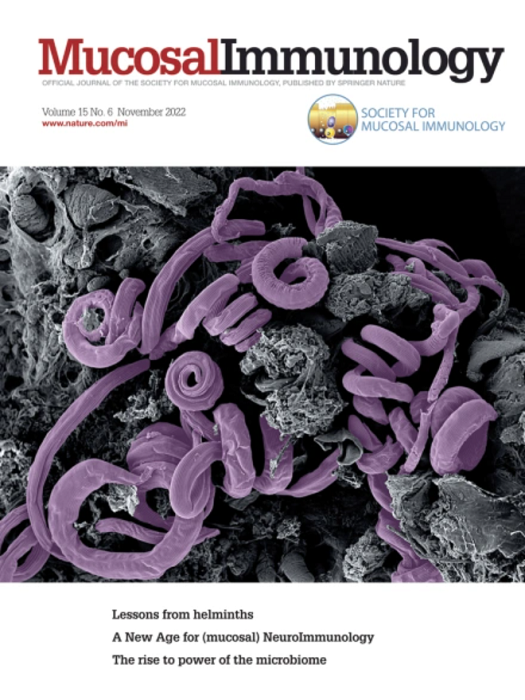肺常驻记忆Th2细胞通过诱导ii型肉芽肿形成调节肺隐球菌病。
IF 7.6
2区 医学
Q1 IMMUNOLOGY
引用次数: 0
摘要
肺驻留记忆T细胞(lung -resident memory T cells, TRMs)在肺内定居,对外界抗原反应迅速,因此被认为在呼吸道疫苗的开发中具有很大的潜力。在这里,我们证明了肺常驻记忆Th2细胞(肺TRM2)可以预防由加蒂隐球菌引起的肺真菌病。我们开发了一种新型的全细胞鼻内疫苗,使用一种热灭活的加蒂杆菌胶囊缺陷菌株cap59Δ,该菌株诱导ST-2+ Gata-3+肺TRM2特异性应答加蒂杆菌全细胞抗原。免疫小鼠感染后肺真菌负荷和生存率显著提高。免疫抑制剂FTY720不影响疫苗的有效性,将肺TRMs过继转移到rag -1缺陷小鼠中可减少肺真菌负荷。在IL-4/IL-13双敲除(DKO)小鼠中,免疫不能有效诱导嗜酸性粒细胞募集和肉芽肿形成,感染后真菌负荷没有减少。在抗原存在的情况下,肺TRM2与髓系共培养诱导了多核巨细胞(MGCs),这些细胞吞噬活的加蒂梭菌细胞而不进行活化,而来自DKO小鼠的肺TRM2不诱导MGCs。这些发现提供了肺部TRM2通过诱导肉芽肿抑制加蒂杆菌感染的新模型。本文章由计算机程序翻译,如有差异,请以英文原文为准。

Lung-resident memory Th2 cells regulate pulmonary cryptococcosis by inducing type-II granuloma formation
Lung-resident memory T cells (lung TRMs) settle in the lung and respond rapidly to external antigens, and are therefore considered to have great potential for development of respiratory vaccines. Here, we demonstrate that lung-resident memory Th2 cells (lung TRM2) protect against pulmonary mycosis caused by Cryptococcus gattii. We developed novel whole-cell intranasal vaccines using a heat-inactivated C. gattii capsule-deficient strain cap59Δ, which induced ST-2+ Gata-3+ lung TRM2 specifically responding to C. gattii whole-cell antigen. Lung fungal burden and survival rate were significantly improved in immunized mice after infection challenge. The immunosuppressive agent FTY720 did not impact vaccine effectiveness, and adoptive transfer of lung TRMs into Rag-1-deficient mice decreased the lung fungal burden. In IL-4/IL-13 double-knockout (DKO) mice, immunization did not efficiently induce eosinophil recruitment and granuloma formation, and the fungal burden was not decreased after infection challenge. Co-culture of lung TRM2 with myeloid lineages induced multinucleated giant cells (MGCs) in the presence of antigen, which phagocytosed live C. gattii cells without opsonization, whereas lung TRM2 from DKO mice did not induce MGCs. These findings provide a new model in which lung TRM2 suppress C. gattii infection via granuloma induction.
求助全文
通过发布文献求助,成功后即可免费获取论文全文。
去求助
来源期刊

Mucosal Immunology
医学-免疫学
CiteScore
16.60
自引率
3.80%
发文量
100
审稿时长
12 days
期刊介绍:
Mucosal Immunology, the official publication of the Society of Mucosal Immunology (SMI), serves as a forum for both basic and clinical scientists to discuss immunity and inflammation involving mucosal tissues. It covers gastrointestinal, pulmonary, nasopharyngeal, oral, ocular, and genitourinary immunology through original research articles, scholarly reviews, commentaries, editorials, and letters. The journal gives equal consideration to basic, translational, and clinical studies and also serves as a primary communication channel for the SMI governing board and its members, featuring society news, meeting announcements, policy discussions, and job/training opportunities advertisements.
 求助内容:
求助内容: 应助结果提醒方式:
应助结果提醒方式:


